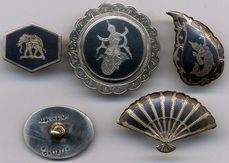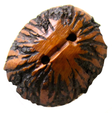Below is a list of categories from which you can choose a favorite "N" or "O" button(s) to bring for "Show 'N Tell.". If there is not a website link with the description, you can try google-ing the term and add the word "images" to find photos of the type. Also look for Nickels, Nature, Oranges, Oblongs, Orchids, Oats, Owls, etc..
Navy Buttons: Buttons made for uniforms of US Navy service people. www.usmilitariaforum.com/forums/index.php?/topic/173001-us-military-uniform-buttons-interesting-facts/
Needlework Buttons: Buttons embellished with crochet-work or embroidery.
New Haven and Baltimore Button Company (N.H.&B. Co.): 1801-1831 Waterbury, Conn.
Newell Brothers Button Company: 1840’s-1900’s, manufactured shell, fabric and vegetable ivory buttons at separate times.
Nickel Silver: Alloy of copper, nickel and zinc. Sometimes called German silver. Not a generally popular material for buttons but the one button known for being made of nickel silver is a US Air Force button. Nickel silver reacts to acids.
Nicolene, Nicolite: Trade-name of a nickel-plated metal used to trim buttons, including small sequin-size circles added to shell, vegetable ivory, composition, glass and metal buttons. Also used as background for window, moon and water designs of pictorial buttons. Rusts easily so it is not always recognized in buttons.


Novelty Button Company: Rubber button makers. Backmark: N.R.Co., along with Goodyear and the 1851. Metal shanks or holes.patent date. (Excellent resource for rubber buttons: www.vintagebuttons.net/rubberbuttonsbook.html
Nut Buttons: In first half of 20th century, almonds, Brazil nuts and filberts were used to make buttons by adding wire loops. Hazelnut and black walnuts were sliced and hole-punched.
Nylon Buttons: A translucent plastic substance. The only nylon buttons found have two holes and a colored circle for decoration. Very difficult to distinguish from other translucent buttons.
Oak Hall Clothing Company: Uniform Buttons from 1890’s-1900’s used by this company and featuring the company name occasionally on back.
Oblique Design: A particular button designed featuring the head of Henry Clay, which is only visible when it reflects light because the engraving is so fine that the surface appears to be perfectly flat. The process is no longer known. Made by Scovill & Company, considered to be among the very rarest of campaign buttons, as well as Golden Age buttons.
O’Hara Dial Company: Primarily made vitreous enamel dials for watches, clocks and phones, but also, some buttons in about 1895. Beautifully decorated with foil. Scarce.
Omega-Type Button: Shanks in the shape of the Greek letter “Omega.” Buttons with these shanks were among the first to be made with machinery in the early 1800’s. The eye of the Omega shank is slightly rounder than the Alpha shank and the ends bend over more to create a larger base for attaching to button. Almost all Omegas have trademarks on the backs, shanks are heavier and the bodies are thicker. Also found are Omega-Rimmed Type buttons that feature a crimped ring along the edge of the button, which creates a border. www.buttoncountry.com/BackTypes2.html
Opal Design: A very rare design found on Golden Age buttons and only on buttons made by the R. & W. Robinson firm in Atteboro, Mass. Produced by a microscopic grooving of the surface that breaks up the light as it is reflected. The colors reflected are iridescent — hence the tie-in with “Opal.”
Outline Designs: Glass buttons with a finely molded outlined barely scratched into the surface and commonly filled with gold, silver or white paint.
Overall Buttons: Buttons on jackets or coats called “jumpers’, which were made to be worn with overalls. Even thought these buttons are often called “overall buttons” they were never used on overalls, just the “jumpers.” Brass on the fronts, iron with black lacquer or tin on the back. Loose shank or holes. Many have designs, slogans or the garment maker’s names. 100s of different designs available for collecting.
Overlay Trim: Glass buttons with decorations created by fusing glass to the front of a button. Opaque glass often had an overlay of transparent glass and transparent glass was often trimmed with opaque glass that was banded, dotted, swirled, tipped or threaded.
 RSS Feed
RSS Feed